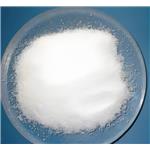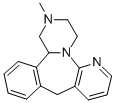- Mirtazapine
-

- $1.00 / 1KG
-
2025-01-10
- CAS:61337-67-5
- Min. Order: 1KG
- Purity: 99%
- Supply Ability: 1ton/month
- MIRTAZAPINE
-

- $90.00 / 1kg
-
2024-08-27
- CAS:61337-67-5
- Min. Order: 10kg
- Purity: 0.99
- Supply Ability: 20tons
- Mirtazapine
-

- $0.00 / 1kg
-
2024-05-21
- CAS:61337-67-5
- Min. Order: 1kg
- Purity: 99%
- Supply Ability: 10000kg
|
| | Mirtazapine Basic information |
| Product Name: | Mirtazapine | | Synonyms: | 1,2,3,4,10,14B-HEXAHYDRO-2-METHYLPYRAZINO[2,1-A]PYRIDO[2,3-C][2]BENZAZEPINE;1,2,3,4,10,14b-Hexahydro-2-methylpyrazino[2,1-α]pyrido[2,3-c][2]benzazepine;Mirtazepine, 1,2,3,4,10,14b-Hexahydro-2-methylpyrazino[2,1-a]pyrido[2,3-c][2]benzazepine;ORG-3770;MIRTAZANINE;MIRTAZEPINE;REMERON;1,2,3,4,10,14b-Hexahydro-2-methylpyrazino[2,1-a]pyrido[2,3-c]benzazepine | | CAS: | 61337-67-5 | | MF: | C17H19N3 | | MW: | 265.35 | | EINECS: | 641-354-1 | | Product Categories: | Pharmaceutical raw material;Serotonin;Intermediates & Fine Chemicals;Pharmaceuticals | | Mol File: | 61337-67-5.mol |  |
| | Mirtazapine Chemical Properties |
| | Mirtazapine Usage And Synthesis |
| Description | Mirtazapine is an antidepressant launched in the Netherlands.
Mirtazapine is a potent antagonist of presynaptic α2 receptors as well as a
moderately potent 5-HT antagonist. Studies suggested that blockade of α2-adrenoceptors,
but not inhibition of noradrenaline uptake, is involved in the
mechanism of the antidepressant action of mirtazapine. Mirtazapine has
demonstrated efficacy in various studies in depressed patients, being equal or more
potent than mianserin, amitriptyline, etc. and exhibiting less anticholinergic and
gastrointestinal side effects and low cardiovascular toxicity. In addition to its
antidepressant effects, studies in animals indicated that mirtazapine has anxiolytic
andor hypnotic activity. | | Chemical Properties | White Crystalline Solid | | Originator | Organon (Netherlands) | | Uses | antidepressant;antagonist at the H1, 5-HT2A, 5-HT2C, 5-HT3, and a2-adrenergic receptors, in that order of potency | | Uses | An a 2-Adrenergic blocker. An analogue of Mianserin. Antidepressant | | Definition | ChEBI: Mirtazapine is a benzazepine and a tetracyclic antidepressant. It has a role as an alpha-adrenergic antagonist, a serotonergic antagonist, a histamine antagonist, an anxiolytic drug, a H1-receptor antagonist and a oneirogen. | | Manufacturing Process | 1) 1-(3-Cyanopyridyl-2)-2-phenyl-4-methylpiperazine
17.43 g (0.3 mol) potassium fluoride is added to a solution of 13.85 g (0.1mol) 2-chloronicotinonitrile and 17.62 g (0.1 mol) 1-methyl-3-phenylpiperazine in 250 ml dry DMF and the suspension is heated at 140°Cunder a nitrogen atmosphere for 20 hours. After cooling, the reaction mixtureis poured into 1,250 ml water. The aqueous phase is extracted four times withethyl acetate the combined organic extracts are washed with 100 ml water.After drying, the extracts are evaporated. The crude oil may be used as suchfor the following step. The nitrile obtained may however also be purified bycolumn chromatography on SiO2, with hexane-acetone (95:5). In this way,21.9 g (79%) pure 1-(3-cyanopyridyl-2)-4-methyl-2-phenylpiperazine isobtained; the substance crystallizes from petroleum ether; melting point 66.5-67.5°C.
2) 1-(3-Carboxypyridyl-2)-2-phenyl-4-methylpiperazine
The solution of 19.5 g (0.07 mol) 1-(3-cyanopyridyl-2)-4-methyl-2-phenylpiperazine in 390 ml of a solution of 25 g KOH/ 100 ml ethanol isheated at 100°C for 24 hours. After cooling, water (390 ml) is added. Thealcohol is evaporated under vacuum and the cloudy solution remaining isextracted twice with 100 ml methylene chloride. The residual aqueous phaseis cooled and the pH is adjusted to 7 with 2 N HCl, after which it is extractedwith chloroform. After drying the chloroform extract, it is evaporated and 16.2g 1-(3-carboxypyridyl-2)-4-methyl-2-phenylpiperazine is obtained as acolourless oil. Crystallization from ethanol gives a crystalline substance with amelting point of 161-162°C.
3) 1-(3-Hydroxymethylpyridyl-2)-2-phenyl-4-methylpiperazine
20.4 g (0.07 mol) 1-(3-carboxypyridyl-2)-2-phenyl-4-methylpiperazine isdissolved in 300 ml dry THF and gradually added to a boiling suspension of20.4 g LiAlH4in 600 ml dry THF under a nitrogen atmosphere. The mixture isboiled for 4 hours, after which it is cooled in an ice-bath and decomposed byadding 81.6 ml water. The inorganic salts are filtered off. The filtrate is driedand solvent is removed by evaporation, giving a yield of 18.39 g (93%) 1-(3-hydroxymethylpyridyl-2)-2-phenyl-4-methylpiperazine. Recrystallization fromether gives a crystalline product (white needles) of melting point 124-126°C.
4)2-Methyl-1,2,3,4,10,14b-hexahydro-benzo[c]pyrazino-[1,2-a]-pyrido[2,3-c]azepine(Mirtazapine)
6.5 ml concentrated sulfuric acid is added dropwise at room temperature to3.25 g of 1-(3-hydroxymethylpyridyl-2)-2-phenyl-4-methylpiperazine. Duringthe addition, the temperature rises to 35°C. The whole is subsequently stirredfor a few hours, after which 60 g ice is added and the mixture is madealkaline with concentrated ammonia (22 ml). The reaction mixture is thenextracted with chloroform. The chloroform extracts are dried andconcentrated. The crude reaction product crystallizes when ether is added,and the solid obtained is recrystallized from petroleum ether. Yield of 2-methyl-1,2,3,4,10,14b-hexahydro-benzo[c]pyrazino-[1,2-a]-pyrido[2,3-c]azepine 2.43 g; melting point: 114-116°C. | | Brand name | Remeron (Organon). | | Therapeutic Function | Antidepressant, Antihistaminic, Antidiuretic | | Biological Functions | Mirtazapine (Remeron) enhances both serotonergic
and noradrenergic neurotransmission. By blocking
presynaptic α2-adrenoceptors, mirtazapine causes release
of norepinephrine. Indirectly, through noradrenergic
modulation of serotonin systems, mirtazapine also
causes increased release of serotonin. It is an antagonist at the 5-HT2A, 5HT2C, 5-HT3, and histamine receptors
but has minimal affinity for muscarinic or α1-receptors.
Mirtazapine does not inhibit neuronal reuptake of serotonin
or norepinephrine.Weight gain and sedation are
common side effects; sedation necessitates
dosing at bedtime. Mirtazapine does not have significant
effects on cytochrome P450 isoenzymes. | | General Description | Mirtazapine (Remeron) was recently introduced for clinicaluse in the United States; its parent mianserin (pyridyl N replacedwith C-H) was long known to be an antidepressant.It is reported to be faster acting and more potent than certainSSRIs. The mode of action gives increased NE release viaα2-NE receptor antagonism and increased 5-HT release viaantagonism of NE α2 heteroreceptors located on serotoninergicneurons. | | General Description | Mirtazapine (Remeron) is another example of tetracyclicα2-blockers that shows selectivity for α2-receptorsversus 1-receptors. Blockade of central α2-receptors resultsin an increased release of NE and serotonin. This hasprompted its use as an antidepressant. This agent also hasactivity at nonadrenergic receptors. It is a potent blockerof 5-HT2 and 5-HT3 serotonin receptors and at histamineH1-receptors. | | Mechanism of action | Animal studies indicate that the efficacy of mirtazapine as an antidepressant results from enhancing central
noradrenergic and serotonergic activity, possibly through blocking central presynaptic α2-adrenergic
receptors. Blocking these receptors inhibits the negative feedback loop, which increases the release of NE
into the synapse. Mirtazapine also is a potent antagonist at 5-HT2 and 5-HT3 receptors, and it shows no
significant affinity for 5-HT1A or 5-HT1B receptors. Additionally, it displays some anticholinergic properties,
and it produces sedative effects (because of potent histamine H1 receptor antagonism) and orthostatic
hypotension (because of moderate antagonism at peripheral α1-adrenergic receptors). Its antidepressant
effect is comparable to the TCAs and may be better than some SSRIs, especially in patients with depression
of the melancholic type, but at higher doses, it may cause drowsiness and weight gain. The drug generally is
well tolerated, producing no more adverse events (including anticholinergic events) than the SSRIs and fewer
adverse events than the TCAs.
Mirtazapine absorption is rapid and
complete, with a bioavailability of approximately 50% as a result of first-pass metabolism. The rate and extent
of mirtazapine absorption are minimally affected by food. Dose and plasma levels are linearly related over a
dose range of 15 to 80 mg. The elimination half-life of the (–)-enantiomer is approximately twice that of the
(+)-enantiomer. In females of all ages, the elimination half-life is significantly longer than in males (mean
half-life, 37 versus 26 hours). | | Clinical Use | Mirtazapine is a piperazinodibenzoazepine antidepressant that is an isostere of the antidepressant mianserin. A seemingly simple isosteric replacement of an aromatic methine group (CH) in mianserin with a
nitrogen to give a pyridine ring (mirtazapine) has profound effects on the physicochemical properties,
pharmacokinetics, mechanisms of action, and antidepressant activities. Profound
differences between receptor affinity and transporter affinity, pharmacokinetics, regioselectivity in the formation of metabolites, and toxicity are observed for mianserin and mirtazapine and their antidepressant
mechanisms of action. The pyridine ring increases the polarity of the molecule and decreases the measured
partition coefficient and the basicity. Mianserin is a potent inhibitor of NET , whereas mirtazapine has
negligible effects on the inhibition of NET (pKi = 7.1 vs. 5.8 respectively). |
| | Mirtazapine Preparation Products And Raw materials |
|